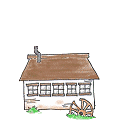posted 2 years ago
Hi Brittany, Great to see that your project is moving forward (We had an email conversation about it back in December 2022)!
When in doubt, consult the applicable building code. In your case it's the IRC Strawbale Construction Appendix AS.
Section AS104.4.1 Plaster and membranes. "Plaster shall be applied directly to the strawbale walls to facilitate transpiration of moisture from the bales, and to secure a mechanical bond between the skin and the bales, except where a membrane is required elsewhere in this appendix."
There's a long discussion in the code commentary about the reason for this, but suffice to say that straw bale walls differ from conventional walls in some ways, and one of them is the need for a vapor/air barrier. The exceptions indicated in the code have to do with applying some form of building paper over wood framing that will be exposed to lime plasters. The recommendation is for a single layer of 15 lb. asphalt felt, or a minimum of 2-ply Grade D asphalt paper. More recent products like stucco drainage papers have come along that can be used as well. I prefer the latter--the layer up against the wood is usually some kind of dimpled or wrinkled vapor permeable but water resistive plastic material (think Goretex) and the layer in contact, and likely to bond with the lime, is a Grade-D asphalt paper. The code doesn't specify overlaps, but the code commentary (and best practice in my opinion) is to cut the building paper several inches wider than the framing it overlays. This helps to prevent wood movement from telegraphing through the plaster and forming cracks. I have seen lots and lots of straw bale walls that didn't observe this practice and can tell you exactly where the framing is hidden behind all those vertical and horizontal cracks. The other exception--I don't think it's mentioned in the code but it's a common practice--is to apply vapor permeable but water resistive membranes over the bale surfaces that might see significantly more water than other parts of the wall. For example, if you decide not to install gutters or you expect several feet of snow banked against your walls during the winter, water splashing from a gutterless roof or melting from the snow could soak through the plaster and into the bales. I have worked on projects where just the lowest course of bales had the 2-ply building paper attached to the bales with landscape pins, the upper edge of the paper folded over the surface of the bale to help keep it in place. The other place I often attach this 2-ply paper to the bales is under windows that don't have projecting window sills. I have repaired a fair number of straw bale walls where wind-driven rainwater running down the window surface soaked into the straw bales below and rotted them out.
Any time you apply this paper over wood framing or a bale surface it also needs a layer of lath because the paper doesn't have enough "tooth" for the plaster to hang onto. Your particular plans probably call for some form of galvanized metal lath/mesh to handle out-of-plane forces. 17 gauge stucco netting or 2x2 welded wire mesh--both galvanized--are both commonly used in straw bale construction in N. America. Note, 17 gauge stucco netting is often referred to as "chicken wire" but don't make the mistake of substituting actual chicken wire! I have done plenty of work on older straw bale walls that were failing because they used chicken wire, which has a lighter galvonic coating and isn't designed to bear the 15 lbs. per square foot weight of 1" thick lime (or clay!) plaster. The plaster can sag and the chicken wire can degrade (rust) quickly if exposed to seasonal or frequent wetting. This is most common at the base of a wall where rain splashes or misaligned sprinklers keep the wall wet.
This highlights an important function, and a limitation of plaster applied directly to the exterior of a straw bale wall. In these applications plasters are considered a reservoir cladding system--some wind driven rain striking the plaster will run off and some will soak in. A lot of moisture can soak into 1" plus thick lime plaster, and it's meant to dry out between rain storms. And in areas with lots of non-stop wind-driven rain with little opportunity for drying, the moisture can't get back out quickly enough, which leads to problems. Thus the importance of knowing your building site's micro climate and designing the roof overhangs appropriately, and of course, working with dry straw bales and keeping them dry.
Your dad is right to be cautious. In conventional construction building wraps serve as weather resistive barriers that prevent water that somehow makes it through a siding system from reaching the insulation. If the barrier is well applied, it can also greatly reduce air movement that transports water vapor (and heat!) into or out of the house. It is possible to apply a vapor permeable weather resistive barrier around an entire straw bale building, but then you also need to apply some form of lath/mesh around the entire building as well. Your plans may call for the lath/mesh anyway, but know that you'll be punching thousands of holes through the membrane as you sew through the walls to tighten the interior and exterior mesh panels and use landscape pins to keep the mesh flat to the wall. This sort of defeats the purpose of the membrane, or at least reduces it's effectiveness should water make it all the way through the plaster.
A well applied exterior lime plaster (or clay plaster where appropriate) serves this function so long as the plaster isn't overwhelmed by wind-driven or ground splashing rain or melting snow. But if you pair a well-applied exterior plaster with good design (generous roof overhangs, gutters, minimum elevation above grade of 8", etc.), there's no need for a barrier separating the straw from the plaster.
Note as well that the greatest moisture threat to the bale wall is often during the plaster application process. Some builders recommend pre-wetting the bales prior to applying plaster, or they over-wet the base coats prior to next coat application, or they over-wet the plaster during the required damp curing process. Wetting may make the plaster easier to work with, but it also can drive liquid water through the plaster (which is porous!) into the bale surface, and while the plaster itself is vapor permeable, it can't release bulk water from the bales quickly enough to prevent them from beginning to decompose. If you're careful about working with dry bales and you time the plaster application to a season where you don't need to constantly spray the walls while damp curing, you'll be fine. There's a reason that lime plasters were traditionally applied in the spring and fall when it was cool (but not cold!) and damp.
A copy of the straw bale building code with commentary can be downloaded at no cost from the California Straw Building Association's website, www.strawbuilding.org.
Jim
Many Hands Builders

 1
1




 1
1




 2
2




 1
1




 3
3




 8
8












